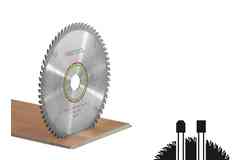Cutting Plexiglas with ease

Description
The following application example explains how you can cut a pane of Plexiglas with ease.
Tools/accessories
Alternative tools
Preparation/set-up
-
The use of the correct saw blade in combination with a speed suitable for the material is particularly important and a decisive factor determining the cutting quality. If you process heat-sensitive Plexiglas at an excessive cutting speed and work with the wrong saw blade, there is a risk of the material melting at the cutting edges. However, if you use a fine tooth saw blade with at least 48 teeth and the correct tooth geometry for cutting, you will achieve a clean cutting result.
Observe the manufacturer's recommendations when setting the speed and carry out a test cut. If the cutting edge melts during the test cut, the feed rate should be increased (not usually possible for manual feed) or the speed should be reduced on the tool.

-
- Insert the fine tooth saw blade in the plunge-cut saw.
- Use the scale on the tool to set the cutting depth to a material thickness of +7–10 mm. To do so, press the cutting depth indicator towards the saw blade and set the required depth for cutting.
- Set the speed to a value that was determined to be suitable during a test cut.
- Place the Plexiglas on a work bench (e.g. MFT multifunction table) or wooden supports.
- If the Plexiglas is thin, use a cutting board, so that it does not sag while you are sawing.
- Then place the guide rail on the workpiece according to the scribe mark and secure it with the appropriate fastening clamps for guide rails or the lever clamps.
- Then connect the extractor hose for the dust extractor to the portable circular saw and the plug-it cable to the mobile dust extractor in order to cut the Plexiglas.

Procedure
-
- The portable circular saw is then placed on the guide rail in front of the workpiece.
- Unlock the plunging device by pushing the green knob forward with your thumb. Switch the tool on and plunge the saw blade in front of the workpiece.
The Plexiglas and the twin-wall sheeting can be cut perfectly straight and splinter-free by slowly guiding the portable circular saw at an even feed rate along the rail.

-
Our illustrated guides and work results are documented working steps that we have performed in practice. They are individual examples and do not guarantee or promise that users will obtain the same results. The results will depend on the user's experience and skill, as well as the material being used. Illustrated guides do not replace any Festool operating manuals and/or safety instructions. Liability for ensuring that the information, instructions and applications are free from content defects and defects of title, in particular with regard to the absence of defects, correctness, freedom from third party intellectual property rights and copyrights, completeness and fitness for purpose, is excluded. Claims for damages made by the user, regardless of their legal basis, are excluded. These liability exclusions are not applicable if the damage was intentional or caused by gross negligence, or in cases of statutory liability.
We cannot accept liability for damage resulting from defects.↑










































